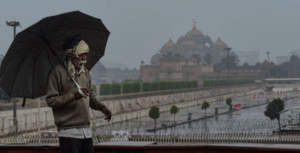Residents Swelter as Delhi NCR Hits the Hottest Day of the Year
India’s capital city, Delhi, witnessed the hottest day of the year on Tuesday as daytime temperatures soared to an all-time high of 49.9°C. The Indian Meteorological Department (IMD) has issued a red “heatwave” warning for the capital city over the next three days.
Mungeshpur(Delhi) recorded the Highest Maximum Temperature of 49.9 °C this summer on 28th May, 2024#heatwavealert #heatwave #weatherupdate@moesgoi@DDNewslive@ndmaindia@airnewsalerts pic.twitter.com/ai5TYTaln8
— India Meteorological Department (@Indiametdept) May 28, 2024
IMD’s Safdarjung observatory, the official marker for the city’s daily temperature record, recorded 45.8 °C, five degrees above normal. While several areas in the Delhi-NCR region, including Narela (49.9°C), Najafgarh (49.8°C), and Mungeshpur (49.9°C), recorded temperatures eight degrees above normal, experiencing severe heat wave conditions.

For the past week, severe heatwave conditions have once again been observed in various parts of the country, just when people were expecting the monsoons to arrive and bring relief from the scorching summer heat. The growth of human demographics, increasing deforestation for widening major roads in cities, and the rapid concretization of megacities are exacerbating the extreme summer heat.
पंजाब, हरियाणा-चंडीगढ़-दिल्ली, पश्चिम राजस्थान के कई हिस्सों, उत्तर प्रदेश के कुछ हिस्सों, पूर्वी राजस्थान, मध्य प्रदेश के अलग-अलग हिस्सों में 29 मई, 2024 को उष्ण लहर से लेकर गंभीर उष्ण लहर की स्थिति और जम्मू संभाग, हिमाचल प्रदेश, विदर्भ, छत्तीसगढ़, pic.twitter.com/kJkS9oyV5e
— India Meteorological Department (@Indiametdept) May 28, 2024
The high temperatures recorded in Delhi-NCR on Tuesday shattered the previous record of 49.2°C, set on May 15-16, 2022. Climate experts are speculating that the average mean temperature will rise above 50 °C, a critical threshold for human survival.

Mahesh Palawat, Vice President of Meteorology and Climate Change at Skymet Weather, said in a statement, “In open areas with vacant land, there is increased radiation. Direct sunlight and a lack of shade make these regions exceptionally hot.”
He pointed out that the majority of the places in Delhi-NCR that are recording 49.9°C are situated on the outskirts of the city and are frequently exposed to hot winds originating from the desert state of Rajasthan.
The incessant summer heat makes residents yearn for the monsoon’s arrival
This year’s long summer season, with frequent heatwaves, has left people yearning for the monsoon’s arrival. The IMD has not released any official statements on the start of the rains in the capital, but unconfirmed reports suggest that the monsoon will begin in Delhi on June 27.

According to IMD’s predictions, the south-westerly monsoon winds will hit Kerala on May 31, with a margin of error of ±4 days. The incessant heat experienced across India this year has raised concerns about the growing effects of climate change, exacerbated by increased deforestation and urban concretization.
Monsoon Alert : One of the best pictures of this year: huge convection over the Arabian Sea. Looks like the classic onset of the monsoon over Kerala and Karnataka in the coming days.
Image: IMD pic.twitter.com/0kAK3H2p3K— 𝐃𝐫 𝐏𝐫𝐚𝐝𝐞𝐞𝐩 𝐊𝐮𝐬𝐡𝐰𝐚𝐡𝐚 (@pkusrain) May 28, 2024
For other megacities in India like Mumbai, Kolkata, and Bengaluru, the IMD has announced that rains will begin in Bengaluru around June 13 or 14. Mumbai is expected to receive rain between June 10 and 11.
Meanwhile, Kolkata is still recovering from the catastrophic effects of Cyclone Remal, which passed through the state a few days ago. However, TOI reports indicate that the monsoon will arrive in West Bengal between June 10 and 29.

While the arrival of monsoons will bring relief from the deadly heat, climate scientists warn that every other season is poised to become more intense and deadly than ever before.
According to a UN report on climate change published on May 17, 2024, it is projected that by 2050, 148.3 million (14.83 crore) people in India will be living in severe climate hotspots.
Govt Action Urgent to Prevent Future Weather-Related Fatalities
According to an NDTV report, 21 bodies were recovered from Kota alone in the last 48 hours. State health officials in Rajasthan have refuted claims that the deceased died due to excessive heat exposure. However, local eyewitness reports suggest that the majority of the deceased were homeless and lived without much shade from the scorching summer sun.

As heatwaves become a regular trend in India, deaths resulting from extreme weather events have also risen. While the government plans to mitigate these deaths by implementing green initiatives, meaningful change seems far away.
Observed Maximum Temperature Dated 28.05.2024
#maximumtemperature #weatherupdate @moesgoi @DDNewslive @ndmaindia @airnewsalerts pic.twitter.com/uYMCgL8XdW
— India Meteorological Department (@Indiametdept) May 28, 2024
If the government refuses to address this critical issue related to deaths from extreme weather events, the general public will bear the brunt of climate change more than any other segment of society in the foreseeable future.











